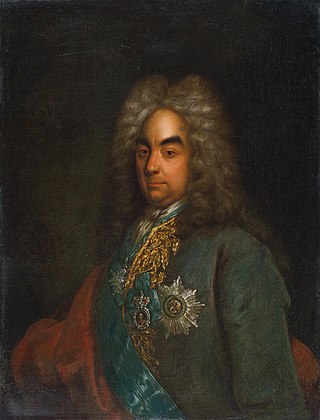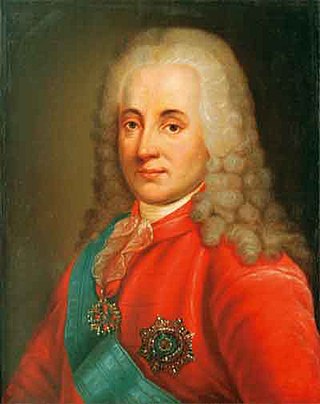
Catherine IAlekseevna Mikhailova was the second wife and empress consort of Peter the Great, and Empress Regnant of Russia from 1725 until her death in 1727.

Elizabeth Petrovna,, also known as Yelisaveta or Elizaveta, reigned as Empress of Russia from 1741 until her death in 1762. She remains one of the most popular Russian monarchs because of her decision not to execute a single person during her reign, her numerous construction projects, and her strong opposition to Prussian policies.

Anna Ioannovna, also russified as Anna Ivanovna and sometimes anglicized as Anne, served as regent of the duchy of Courland from 1711 until 1730 and then ruled as Empress of Russia from 1730 to 1740. Much of her administration was defined or heavily influenced by actions set in motion by her uncle, Peter the Great, such as the lavish building projects in St. Petersburg, funding the Russian Academy of Science, and measures which generally favored the nobility, such as the repeal of a primogeniture law in 1730. In the West, Anna's reign was traditionally viewed as a continuation of the transition from the old Muscovy ways to the European court envisioned by Peter the Great. Within Russia, Anna's reign is often referred to as a "dark era".

Peter II Alexeyevich reigned as Emperor of Russia from 1727 until 1730, when he died at 14. He was the only son of Tsarevich Alexei Petrovich and of Charlotte Christine of Brunswick-Lüneburg. He was the last male agnatic member of the House of Romanov.

Count Andrey Ivanovich Osterman was a German-born Russian statesman who came to prominence under Tsar Peter I of Russia and served until the accession of the Tsesarevna Elizabeth in 1741. He based his foreign policy on the Austrian alliance. General Admiral.

Count Fyodor Matveyevich Apraksin was one of the first Russian admirals, governed Estonia and Karelia from 1712 to 1723, was made general admiral (1708), presided over the Russian Admiralty from 1718 and commanded the Baltic Fleet from 1723.
History of Russia (1721–96) is the history of Russia during the Era of Russian palace revolutions and the Age of Catherine the Great. It began with creation of Russian Empire in 1721, the rule of Catherine I in 1725, and ended with the short rule of Peter III in 1762.

The House of Golitsyn or Galitzine was one of the largest princely of the noble houses in the Tsardom of Russia and Russian Empire. Among them were boyars, warlords, diplomats, generals, stewards, chamberlains, the richest men of Russia, and provincial landlords. Since 1694 Bolshiye Vyazyomy was one of the ancestral estates of the Golitsyns, but many others, like Arkhangelskoye Palace and Dubrovitsy near Podolsk, were owned by different branches or members of the family.

Count Pyotr Andreyevich Tolstoy was a Russian statesman and diplomat, prominent during and after the reign of Peter the Great. He was the ancestor of all the Counts Tolstoy, including the novelist Leo Tolstoy and Alexei Tolstoy the writer. His wife was Solomonida Timofeevna Dubrovskaya born 1660 and died 1722; he had two sons with her, Ivan and Peter. Both his sons died in exile with him the year before his own death. He was, however, survived by many grandchildren: the family was recalled by the Empress Elizabeth, daughter of Peter the Great in 1760, and had all honors and land restored.

Count Gavrila (Gavriil) Ivanovich Golovkin was a Russian statesman who formally presided over foreign affairs of the Russian Empire from 1706 until his death. The real control over Russian diplomacy during his lengthy term in office was exercised by Boris Kurakin until 1727 and by Andrey Osterman after his death.

Grand Duchess Anna Petrovna of Russia was the eldest daughter of Emperor Peter I of Russia and his wife Empress Catherine I. Her younger sister, Empress Elizabeth, ruled between 1741 and 1762. While a potential heir in the reign of her nephew Peter II, she never acceded to the throne due to political reasons. However, her son Peter III became Emperor in 1762, succeeding Elizabeth. She was the Duchess Consort of Holstein-Gottorp by marriage. She was born in Moscow and died in Kiel in her youth, at the age of 20.

The Conditions were an 18th-century constitutional project in Russia, signed by Empress Anna of Russia in Mitau on 18 January 1730, giving substantial power to the Supreme Privy Council. When the Empress returned to Russia, she revoked her approval of the Conditions and dissolved the Supreme Privy Council on the 20 February. The members of the council were removed from government and exiled or repressed paving the way for Anna to become an absolute monarch in the model of her uncle Peter the Great.

Tsarevna Catherine Ivanovna of Russia was a daughter of Tsar Ivan V and Praskovia Saltykova, eldest sister of Empress Anna of Russia and niece of Peter the Great. By her marriage, she was a Duchess of Mecklenburg-Schwerin.

Prince Dmitry Mikhailovich Golitsyn was a Russian aristocrat of the Golitsyn family. A cousin of Prince Vasily Vasilyevich Golitsyn, he was noted for his noble attempt to turn Russia into a constitutional monarchy.

Prince Mikhail Mikhailovitch Golitsyn or Galitzin was a Russian admiral and diplomat.

The Cabinet of Ministers was the supreme state body established on November 4, 1731 by the decree of Empress Anna Ioannovna. On December 23, 1741, after the accession of Elizabeth Petrovna, it lost its powers and was transformed into the Personal Office of the Empress. In 1756, its functions were transferred to the Conference at the Highest Court.

Baron Ivan Antonovich Cherkasov was a Russian statesman, privy councillor, cabinet secretary to Peter the Great, Catherine I and Elizabeth Petrovna. From him comes the baronial clan of Cherkasovs.

The Count Pavel Ivanovich Yaguzhinsky (Yagushinsky) was a Russian statesman and diplomat, associate of Peter the Great, Chamberlain (1712), Ober-Stallmeister (1727), General-in-chief (1727), the first Attorney General in Russian history. He was famous for his honesty and integrity, which Peter the Great appreciated in him in the first place.

Prince Alexander Borisovich Kurakin was a statesman and diplomat from the Kurakin family: an Active Privy Councillor, the Ober-Stallmeister (1736), a senator.
The prosecutor general was one of the highest government positions in the Russian Empire, the head of the Governing Senate, who oversaw the legality of the activities of government agencies.


















